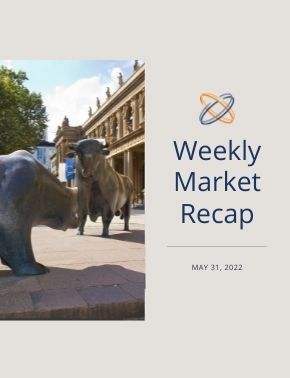Week in Review
Equity Markets:
The S&P’s losing streak came to an end last week. The S&P finished the week up over 6.6%. After fighting off a technical bear market in the S&P, the rally was a welcomed sight for investors after seeing seven straight weeks of red.
Earnings season is almost complete. Of the ~97% of companies that have reported, 77% have beat earnings expectations and 73% have beat sales expectations, according to FactSet. These numbers are in line with the 5-yr average. Companies that have beat expectations are doing so at a smaller rate than the 5-yr average according to FactSet. Macroeconomic conditions have put pressure on profit margins for many companies and are likely the major cause of a lower earnings surprise rate. Earnings growth has been 9.2% thus far.
Fixed Income Markets:
The minutes from the last FOMC meeting were released on Wednesday. The minutes confirmed the hard stance the Fed is willing to take to battle inflation. The minutes revealed the Fed is prepared to hike rates by 50 basis points at their next two meetings; they acknowledged that continued rate hikes could have a negative impact on economic growth. Fed members continue to state their goal for a “neutral” rate environment that will slow inflation without inhibiting economic growth.
The 10-yr Treasury yield ended the week at 2.74%, nearly flat for the week. The negative correlation between fixed income and equities seems to have returned after months of bonds and equities losing value together.
Economic:
The major headline for the week was the Personal Consumption Expenditures Index, which was reported on Friday. PCE is a preferred gauge for consumer prices by the Fed. Core PCE (excludes food and energy) came in at 4.9% year over year. This reading was in line with expectations and is little changed from the prior few months. This could be a sign that inflation has started its peaking trend.
The second read on Q1 GDP was revised lower. After a -1.4% reading on the first estimate, Q1 GDP was revised lower to -1.5% due to private inventories and household investment. Another surprise downward revision was the University of Michigan Consumer Sentiment Index to 58.4 from the preliminary read of 59.1.
Looking Ahead
Equity Markets:
With Q1 earnings season nearly complete, companies have held up fairly strong. Amid the market volatility, the S&P 500 had a strong quarter for earnings growth. The growth has slowed year over year. There are two major factors we believe contribute to the slowing. The first, Q1 earnings are the last readings that will be compared to the outsized growth the market saw following the pandemic shutdowns. The second, which is fundamentally more important, is the current macroeconomic headwinds. According to earnings calls transcriptions completed by FactSet, many companies have expressed concerns about the impacts of inflation and the geopolitical events taking place in Eastern Europe.
Despite the strong returns from last week, we believe that investors should continue with their disciplined investment plan. It can be easy to let the run-up of last week push the prior few months to the back of your mind. Volatility will likely remain going forward and it is important for investors to be positioned with the proper risk allocation in their portfolios.
Fixed Income Markets:
Going forward we see rates likely moving back above 3%. After seeing bonds move in unison with equities for most of the year, the negative correlation benefits have returned in the past two weeks. For fixed-income investors, today’s environment is much more attractive than just six months ago. We believe we are closer to the top end of rates, 3.25-3.5%, and opportunities in the bond market are starting to appear. Along with more attractive rates, the level of downside protection to offset an investor’s equity risk is much more attractive at current levels.
Economic:
The Fed’s Beige Book will be released this week. This provides insight into the levels of business activity across the nation in preparation for the June 15 policy meeting. We will also see reads on the Consumer Confidence Index, Job Openings and Labor Survey, and the usual labor market reports.
Recession worries have started to become more prevalent. Economic numbers have softened lately, but it is important to remember growth is still occurring. Economic growth does not move linearly and there are ebbs and flows through the entire cycle.
Important Disclosures:
Investment Advisory Services offered through Krilogy®, an SEC Registered Investment Advisor. Please review all prospectuses and Krilogy’s Form ADV 2A carefully prior to investing. This is neither an offer to sell nor a solicitation of an offer to buy the securities described herein. An offering is made only by a prospectus to individuals who meet minimum suitability requirements.
All expressions of opinion are subject to change. This information is distributed for educational purposes only, and it is not to be construed as an offer, solicitation, recommendation, or endorsement of any particular security, products, or services.
Diversification does not eliminate the risk of market loss. Investments involve risk and unless otherwise stated, are not guaranteed. Investors should understand the risks involved of owning investments, including interest rate risk, credit risk and market risk. Investment risks include loss of principal and fluctuating value. There is no guarantee an investing strategy will be successful. Past performance is not a guarantee of future results. Indices are not available for direct investment; therefore, their performance does not reflect the expenses associated with the management of an actual portfolio. The S&P data is provided by Standard & Poor’s Index Services Group.
Services and products offered through Krilogy® are not insured and may lose value. Be sure to first consult with a qualified financial advisor and/or tax professional before implementing any strategy discussed herein.














